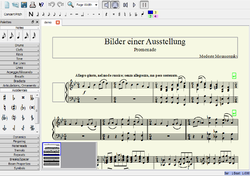- MuseScore
-
MuseScore 

MuseScore 0.9.5, running under Microsoft Windows VistaOriginal author(s) Werner Schweer Developer(s) Werner Schweer Stable release 1.1 / July 27, 2011[1] Development status stable Written in C++ Operating system Microsoft Windows, Linux, Mac Size 34.3 MB installer, 116 MB when installed Available in Afrikaans, Arabic, Asturian, Basque, Brazilian Portuguese, Czech, English, French, Galician, German, Farsi, Hindi, Hungarian, Italian, Portuguese, Russian, Spanish, Turkish, Danish, Finnish, Swedish, Norwegian, Traditional Chinese, Traditional Chinese (Taiwan), Ukrainian, Polish, Romanian, Catalan, Greek, Japanese, Simplified Chinese, Korean, Slovene, Faeroese, Slovak, Lithuanian, Croatian, Belarusian, Vietnamese, Esperanto, Persian Type Scorewriter License GNU General Public License Website musescore.org MuseScore is free and open source music notation software for Microsoft Windows, Mac and Linux. MuseScore is a WYSIWYG editor, complete with support for score playback and import–export of MusicXML and standard MIDI files. Percussion notation is supported, as is direct printing from the program.
The program has a clean user interface, with fast note editing input similar to the step-time note entry found in the popular commercial score writing software packages, Finale and Sibelius.
MuseScore is free software, published under the GNU General Public License.
Contents
Capabilities
MuseScore is able to import and export from many different music formats, including MIDI and MusicXML, as well as the importing of files from the commercial music software Band-in-a-Box, Capella and Overture. It is able to produce engraved output as a PDF, SVG or PNG document, or alternatively, music can be exported to LilyPond for subsequent tweaking of the output. Audio output is also supported as a WAV, Ogg or FLAC file.
Development
MuseScore is an outgrowth of MusE, a MIDI sequencer for Linux. In 2002, Werner Schweer decided to "cut MusE's notation capabilities out of the sequencer and rewrite it as a standalone notation editor."[2] The rewrite is based on the cross-platform Qt toolkit.
Adoption
In September 2008, MuseScore started to see a large growth in the number of downloads following the launch of the musescore.org website.[3] By December 2008, the monthly download rate was 15,000. In the summer of 2009, the release of version 0.9.5 added support for Mac OS and was stable enough for normal use.[4] Download traffic for MuseScore tripled in the four months following the 0.9.5 release. Since October 2009, MuseScore has been downloaded more than 1000 times per day.[5]
On 8 June 2010, version 0.9.6 was released [6]. By the fall of 2010 and with the start of the new academic year, MuseScore tripled its numbers of downloads. [7] Version 1.0 was released on February 7, 2011.
See also
References
- ^ "MuseScore 1.1 is released". musescore.org. 2011-07-27. http://musescore.org/en/musescore-1.1. Retrieved 2011-07-27.
- ^ Dave Phillips, "At the Sounding Edge: Music Notation Software, the Final Installment," Linux Journal (6 April 2006).
- ^ "FOSDEM 2009 wrap up", http://musescore.org/node/982
- ^ http://musescore.org/new-features-musescore-095
- ^ SourceForge, "MuseScore Project download statistics"
- ^ http://musescore.org/en/node/6010
- ^ http://musescore.org/en/node/8099
External links
- MuseScore homepage
- MuseScore mailing list
- MuseScore articles
- Marc Sabatella, MuseScore 1.0 - A Milestone in Free Music Notation Software, February 07, 2011
- David Stocker, Introduction to MuseScore for Musicians and Music Educators, September 3, 2010
- Lee Schlesinger, WYSIWYG music app makes a score, June 21, 2010
- Music Dave Phillips, Notation Software for Linux, April 22, 2009
- MusTech.net review, October 7, 2008
- David Bolton first impressions on MuseScore
- About.com review, March 24, 2008
- Dave Phillips: Music Notation Programs: Recent Releases, Feb 25, 2008
Scorewriters Open source Denemo • Frescobaldi • GNU LilyPond • Impro-Visor • MuseScore • MusiXTeX • NoteEdit • Rosegarden • TuxGuitarFreeware Proprietary Capella • Encore • Finale • Guitar Pro • Igor Engraver • Mozart • Mus2 • MusEdit • MusiCAD • Music Write • NOTION • NoteWorthy Composer • Overture • SCORE • Sibelius • SmartScoreCategories:- Free music software
- Scorewriters
- Software that uses Qt
Wikimedia Foundation. 2010.
